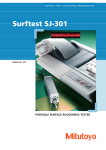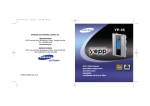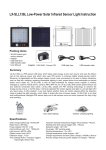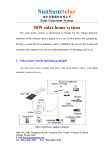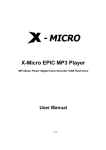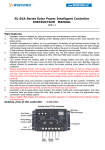Download Samsung YP-T4 H User's Manual
Transcript
YP-T4 - MP3, WMA and ASF Playback - Removable Storage Device - Upgradable - 15-Hour Continuous Play - Voice Recording Function AH68-01728B (Rev 0.0) Contents Additional Usage Preparations Safety Instructions Features Accessories Location of Controls 4 6 7 8 Connection to Computer Connecting the player to a PC Manual Installation of the USB Driver Using the removable storage ● Downloading/Uploading files ● Disconnecting the USB cable ● Formatting Installing Music Studio ● To View Help on Music Studio 10 14 18 18 19 20 21 23 Basic Usage Playing Music and Turning Off the Device Adjusting the Volume/Hold Function Recording Voice Loop Repeating Using Navigation Setting Playlist Setting up MENU Managing Files ● Deleting ● Formatting Setting the Advanced Functions Selecting the Playmode Setting the EQ mode Display ● Scroll Speed / Time ● Backlight ● Contrast / Tag / Language Power Off Time ● Time / Sleep Default Volume Appendix 24 25 26 MENU Table 41 Customer Support Troubleshooting Specifications 2 27 28 29 30 31 31 32 33 34 35 36 36 37 38 39 39 40 42 44 3 Safety Instructions Earphones Read and understand all the instructions to avoid injury to yourself and damage to the equipment. Do not expose to extreme temperatures (above 95°F or below 23°F). Do not expose to moisture. Do not apply excessive pressure to the device. Do not let any foreign matter spill into the device. Follow Traffic Safety Instructions ● ● Do not use the earphones while driving an automobile or riding a bicycle. It’s not only dangerous, but also against the law. An accident may result if you turn up the volume of the earphones too high while walking down the street, especially when crossing at intersections. Protect your ears Do not place heavy objects on top of the device. Do not expose to chemicals such as benzene and thinners. Remove batteries when the device is left unused for a long period of time. ● Do not turn the volume up too high. Doctors warn against prolonged exposure to high volumes. ● Stop using the device or turn the volume down if you get ringing in your ears. Ambient operating conditions Do not expose to direct sunlight or heat sources. 4 Do not store in dusty areas. ● Ambient temperature : 5°C ~ 35°C (41°F ~ 95°F) ● Humidity : 10% ~ 75% Do not try to disassemble and repair the device yourself. ✽ Please be aware that we disclaim all responsibility for damages from loss of saved or recorded data due to breakdown, repair or other causes. Environmental Information ● Follow local guidelines for waste disposal when discarding packaging, batteries,and old electronic appliances. ● Your player is packaged with cardboard, polyethylene etc., and does not use any unnecessary materials. 5 Features Accessories MP3, WMA and ASF Playback ● MP3 is an MPEG1 Layer3 audio format. ● WMA is a Microsoft Windows Media audio format. ● ASF is an advanced streaming file format. Removable Storage Device Earphones USB cable User manual One Battery (1.5V AAA/LR03 type) Neck Strap Installation CD ● You can easily copy and paste files to the player using Windows Explorer. Upgradable Player ● You can upgrade the built-in programs when available. Please check the home page (www.samsung.com) for upgrades. 15-Hour Continuous Play ● This unit uses one AAA/LR03 alkaline battery. Operation can last up to 15hours. Actual playing time may vary according to the type and capacity of the battery. Voice Recording Function ● You can do a Voice Recording with high quality and use it for a conference. Sound ● You can adjust the equalizer manually. 6 Model YP-T4 H YP-T4 V Built-in memory 128MB 256MB ● The capacity of the useable built-in memory is less than indicated as the internal firmware uses a part of the memory as well. ● Design of accessories is subject to change, for the purposes of improvement, without notice. 7 Location of Controls Display Neck strap Hook Display MENU, Navigation button/ Move to Track/Speed Search/ Volume Button Track Number indicator Play/Stop/Pause indicator Equalizer indicator Bit rate indicator Play mode indicator Remaining Battery Power indicator Playtime indicator Title (track & artist) indicator Mode indicator Loop Repeating Button Play/Pause Button Recording Button Hold Switch Microphone Inserting a Battery 1 Earphone Jack 2 USB Cable Connection Port Battery Cover Slide the cover in the direction of the arrow to open. Insert a battery to the right poles + , – and push-close the cover in the direction the arrow as indicated. Note ● 8 Do not place heavy objects on the cover. 9 Connecting the player to a PC System Requirements. The PC system must meet the following specifications: ● Pentium 133MHz or greater. ● Windows 98SE/ME/2000/XP. ● 40MB of available hard disk space ● CD-ROM drive. (double speed or greater) ● USB port (1.1) supported. ● DirectX 8.0 or above. Before connecting the player to PC, make sure to install USB driver. If “Add New Hardware Wizard”appears, press the [Cancel] button and install the USB driver. Installing software 1 2 Follow the instructions in the window to complete the installation. Insert the Installation CD into the CD-ROM drive. Select [Install Player USB Driver]. Note 10 ● Install the operating system in Administrator Account mode for Windows 2000 or XP. Otherwise, installation will not be completed. ● Windows ME, 2000 and XP can recognize the driver without installing the provided program. However, you must install the program in order to format the player and upgrade firmware. ● If the YP-T4 program has not been installed in Windows 98, then it will not communicate with your removable disk. You must install the USB driver file first. Continued... 11 Connecting the player to a PC Connecting the player to a PC with a USB cable 3 4 How to check the USB driver Connect a USB cable to the USB port on the computer. ● Connect the other end of a USB cable to the USB cable connection port on the bottom of the player, and press the button on the main unit. ● ● 6 12 Upon installation of the USB driver "Samsung YP-T4 USB Device" will appear in the [System Properties] → [Device Manager]. Windows 2000: Control Panel → System → Hardware → Device Manager → Disk Drives → Samsung YP-T4 USB Device ● USB connect cable 5 Control Panel → System → Device Manager → Disk Drives → Samsung YP-T4 If you disconnect the USB cable from your PC while implementing a command or initializing during USB driver installation, your PC may not function correctly. The USB driver is installed with a message saying that it is searching for a new device. You may not see the display screen during installation. Go to the device manager to check that installation has been successfully completed. Windows 98/ME: Windows XP: Control Panel → System → Hardware → Device Manage → Disk Drives → Samsung YP-T4 USB Device 7 When the USB driver is not installed automatically, refer to the next page. 13 Manual Installation of the USB Driver Go to “Downloading/Uploading files” on page 18 if the USB driver is in place. Follow these steps if the USB driver is not in place : 4 After selecting the driver, click [Update Driver]. 5 Click [Next]. 6 Select [Search for a suitable driver for my device] and then click [Next]. 7 Click [Next] to finish. When an error occurs during installation of the USB driver 1 Check the device manager. ● Windows 98/ME: ● Windows 2000 (Professional): Control Panel → System → Device Manager Control Panel → System → Hardware → Device Manager ● Windows XP (Professional): Control Panel → System → Hardware → Device Manager 2 3 Check if there is a device listed with an exclamation point or a question mark (displayed as unknown device or USB device). Double click on the device listed with an exclamation point or a question mark. Note If you are using Windows 2000 and your version of Windows does not recognize the USB driver please download and install the latest service pack from windowsupdate.microsoft.com ● The installation method may vary depending on the type of PC or operating system. Contact your PC dealer or service center for installation information. ● If errors occur continuously when you install the USB driver, reconnect the USB cable after rebooting your system. ● 14 15 Manual Installation of the USB Driver In Windows 98 ● Follow the instructions in the window to complete the installation. You must reboot your computer to complete the installation. Note USB driver location [CD ROM]\setup\Drivers 16 ● You cannot use it as a removable disk in Windows 98 if the YP-T4 program is not installed. Make sure to install the USB driver file first. 17 Using the removable storage Disconnecting the USB cable Downloading/Uploading files After completing the file transmission, you must disconnect the cable in the following way: 1 2 3 Connect the player to your PC and turn it on. 1 Open Windows Explorer on PC. Select the file to save and drag-and-drop it into the removable disk icon. (In numerical, alphabetical order) 2 Double-click on the green arrow in the taskbar on the bottom right of the window. When the [ Stop a Hardware device ] message appears, press the [OK] button and disconnect the USB cable. Notice ● The “WRITING/READING” message will appear during file download or upload. Disconnecting the USB cable while “WRITING/READING” is displayed may cause malfunction of the unit. ● The order of music files is not relative to the replay order when you select a Removable Disk in Windows Explorer. Note ● 18 The green arrow is not displayed on the Task Bar in Windows 98 system. If “READY” message is shown in Display window, please disconnect the USB cable. 19 Using the removable storage Installing Music Studio Formatting 1 1 Select the removable disk icon and click the right mouse button to select [Format]. 2 Insert the Installation CD into CD-ROM drive. Select [Install Samsung Music Studio]. Press the [Start] button. ● ● All saved files will be formatted. You can change the name of removable disk by selecting [Volume label]. 2 Select language Note 20 ● By formatting, all previously preset menus will be initialized. ● Care must be taken as formatted files can not be recovered. Continued... 21 Installing Music Studio To View Help on Music Studio 3 Follow the instructions in the window to complete the installation. ● Please refer to Help for more information on how to use Music Studio. Run Music Studio and press F1. ● Help will appear. Move the arrow to the top of Music Studio and right click on the mouse. The following selection window will appear. ● Click on Help and the Help window will appear. Note Music recognition technology and related data are provided by Gracenote and Gracenote CDDB® Music Recognition ServiceSM. ● CDDB is a registered trademark of Gracenote. The Gracenote logo and logotype, the Gracenote CDDB logo and logotype, and the "Powered by Gracenote CDDB" logo are trademarks of Gracenote. Music Recognition Service and MRS are service marks of Gracenote. ● 22 23 Playing Music and Turning Off the Device Adjusting the Volume/Hold Function Adjusting the Volume Turning Power On and Off ● Power On : Press the button to turn on the power. button to turn off the power. ● Power Off : Press and hold the Press the , key during playback to adjust the volume. Playing Music Press the Note button. ● Volume ranges from 00 to 30. ● Playback starts. HOLD Function Pausing Music Press the button to pause playback. In Hold mode, all buttons are disabled. ● If no buttons are pressed within 10 seconds (changes depending on settings), the player automatically powers off. ● While in Pause mode, press the Slide the switch on the player in the direction of the arrow. button again to resume playback. ● When the button is pressed, the “ HOLD!” message will appear on the display. Note WMA files can be played only as music files with a compression rate of 48Kbps-192Kbps, that can be created in Windows Media Player (Version 8.0). ● The power off time can be set in the menu. ● 24 25 Recording Voice 1 2 Loop Repeating Starting Point Press the REC button to start voice recording. If the REC button is pressed again, the recording stops and a voice file is created. While playing music files, press the A↔B button briefly at the beginning of the loop you want to set. A↔ appears in the display. Ending Point Press the A↔B button briefly again to set the end of the loop. A↔B appears in the display. The loop is played repeatedly. Note ● Recording is performed in order (V001, V002, etc.) and files are saved in the WAV format after recording. ● If the Memory is full, the Voice Recording is stopped automatically. Note 26 ● Press the A↔B button briefly to cancel the loop. ● Loop Repeat is automatically released if you Speed Search with the , buttons. 27 Using Navigation Setting Playlist You can easily search for files or switch modes using the Navigation function. 1 Press and hold the button to move to Navigation mode. When the folder is in play or stop status. 2 - Move to the file you want in Navigation mode and press the ● The selected file will be marked. ● To release the playlist setting, move to the marked file in Navigation mode and press the key. key again. When the file is in play or stop status. Select the file or folder that you want to play. : When moving to a higher-level folder. ● ● , ● Press the Playing Playlist : When moving to a lower-level folder. : When moving to a file or folder in the same directory. : Move to the next folder down. When there is not a lower folder, the selected file will be designated as part of the playlist. ● 3 Setting Playlist button. ● The selected file will be played. ● If you select a folder, all the files in the selected folder will be played. 1 2 Press and hold the A↔B button in Music mode. ● The Playlist you set will be displayed. Move to the file you want to play and press the ● button. The selected file will be played. Note ● Press and hold the key in Navigation mode to exit Navigation mode. Note 28 ● Select PLAYLIST in File Delete (see “Deleting”) to release all the playlists you set. 29 Setting up MENU Press the Use the Managing Files key to switch to MENU mode. , key to move and press the Press and hold the Deleting key briefly to select the menu you want. key to exit the MENU mode. Now playing : To check the track currently played. ● File : To delete or format files. ● Settings : To set the detailed function of the play. ● 1 2 3 Select File in the MENU. (refer to “Setting up MENU”) In File, select File Delete and the mode the target file is in. Use the , key to move to the file you want to delete, press the select CONFIRM. Press the key briefly to exit the setting. key and Note ● 30 In MENU mode, no input for 15 seconds will cancel the MENU mode. 31 Managing Files Setting the Advanced Functions Formatting 1 Select File in the MENU. (refer to “Setting up MENU”) 2 Select Format in File. ● Settings 1 2 Select Settings in the MENU. (refer to “Setting up MENU”) In Settings, use the , key to move to the function you want and press the key to select. Formatting is performed if CONFIRM is selected. ● Use key to move to upper menu. Note 32 ● All files will be deleted when formatting the built-in memory. ● It is recommended that formatting be carried out on a PC that has the provided program installed as formatting in the Menu may take a long time. 33 Selecting the Playmode 1 2 Select Playmode in Settings. In Play mode, use the , key to move to the mode you want and press the key to select. Setting the EQ mode 1 2 Select Sound in Settings. In Sound, use the and press the ● Normal: To play all the tracks in order one time. Repeat one: To repeat one track. ● Repeat all: To repeat all tracks. ● Shuffle: To play tracks at random. ● Intro: To listen to the first part of all saved tracks for 10 seconds. , key to move to the sound mode you want key. If you want bass boost, select DBB. ● ● 3 Select User and set the Bass/Treble if you want to set the tone yourself, apart from the specified tone. ● 34 Bass/Treble can be adjusted from 0 to 10 with the , key. 35 Display Backlight Select Display in Settings. Scroll Speed Use the , key to set the scroll speed. ● The setting range for the scroll speed, which adjusts the speed of the track title flow, is 0 to 10. ● [ Light Time - LCD ] ● Use the ● The setting range for Light-On Time is 0 to 10 seconds. , key to set the LCD Light-Off time. ● When set to On, the Light stays on continuously. [ LCD color ] Time Play time: Displays the current play time ● Remain time: Displays the remaining play time ● Used size: Displays the size of memory used. ● Free size: Displays the remaining memory ● ● Use the , key to select the LCD color you want, out of 7 colors. Green N Red Violet N Orange N Sky-Blue N Lilac N Random N Blue N Note ● 36 The light does not illuminate when the residual battery level is insufficient. 37 Display Contrast ● ● Use the , key to set the contrast. The setting range for the contrast, which adjusts the brightness of the screen, is from 0 to 10. Tag Use the , key to select Tag On or Off. On: Display the Tag information if the music file has Tag information. Display the file name if the music file has no Tag information. ● Off: Display the name of music file. ● ● Power Off Time Select Power off in Settings. Time Use the , key to set the Power-Off time. ● You can set the time from 0 to 1 minute. If no key is pressed after play stops, the unit will automatically turn off after the time you set. ● When set to OFF, the power does not turn off automatically. ● Sleep Use the , key to set the Sleep time. 30, 60, 90 and 120 minutes are available for sleep time, and it will automatically turn off after the time you set. ● When set to OFF, the power does not turn off automatically. ● Language ● ● 38 Use the , key to select the language for displaying Tag information. Chinese(S) → Chinese(T) → English → French → German → Hungarian Italian → Japanese → Korean → Russian → Spanish ● 39 Default Volume MENU Table Select Default vol in Settings. Default vol Use the , key to set the default volume value. It is possible to set the default volume to a value between 0 and 25(MAX). If the power is turned on again after having adjusted the volume above the default value, music is played at the default volume. ● If the power is turned on again after the volume was set to within the default value, the music is replayed at the previously played volume. ● ● ● 40 Use the key to move and select. 41 Troubleshooting The software doesn’t work ● The buttons do not work. Refer to the recommended PC specifications. ● ● Check setting of Hold switch. Remove the battery once and then insert it again. The player does not work and the LCD displays nothing. ● ● The player keeps being turned off. Check the battery capacity Check to see if the battery is inserted to the right poles ( + , – ) In PLAY mode, music is not played after pressing the Check to see if MP3 or WMA files are saved in the built-in memory. ● Check to see if the HOLD button is locked. ● In Stop mode, the power is automatically turned off after ten seconds (changes depending on settings). ● Check to see if there are files saved in it. ● button Something’s wrong with play time displayed during Play mode. ● “VBR SONG” message is displayed while VBR (Variable Bit Rate) file is playing. Files cannot be downloaded. ● LCD window is dark ● ● Check to see if the driver is installed correctly in the computer. Check the connection between player and computer. ● Check and/or replace the battery, turn on the player's power. ● Operating system limits the number of files you can save. Please save your music files by creating a subfolder. ● Check if the memory is full. Check Contrast Backlight does not work. ● ● 42 Check the backlight setup. When the battery power is low, the backlight will go out. 43 Specifications Model Built-in Memory capacity Voltage Playing time Dimensions/Weight Case Noise Ratio Earphones Jack Output Power Output Frequency Range Operating Temperature Range File Support MEMO YP-T4 128MB(YP-T4 H), 256MB(YP-T4 V) 1.5V X 1 (AAA/LR03 size alkaline battery) lasts up to 15hours (Alkaline battery, MP3 128Kbps, Vol level 20) 23 X 54 X23 mm / 23 g (without battery) Plastic/Aluminum 80dB with 20KHz LPF 5mW / CH (16 Ω) 20Hz~20KHz -5 ~ +35°C(23~95°F) MPEG1/2/2.5 Layer3(8Kbps ~ 320Kbps, 8KHz ~ 48KHz) WMA, ASF(48Kbps ~ 192Kbps, 8KHz ~ 48KHz) The product unit accompanying this user manual is licensed under certain intellectual property rights of certain third parties. This license is limited to private non-commercial use by end-user consumers for licensed contents. No rights are granted for commercial use. The license does not cover any product unit other than this product unit and the license does not extend to any unlicensed product unit or process conforming to ISO/IEC 11172-3 or ISO/IEC 13818-3 used or sold in combination with this product unit. The license only covers the use of this product unit to encode and/or decode audio files conforming to the ISO/IEC 11172-3 or ISO/IEC 13818-3. No rights are granted under this license for product features or functions that do not conform to the ISO/IEC 11172-3 or ISO/IEC 13818-3. 44 45























